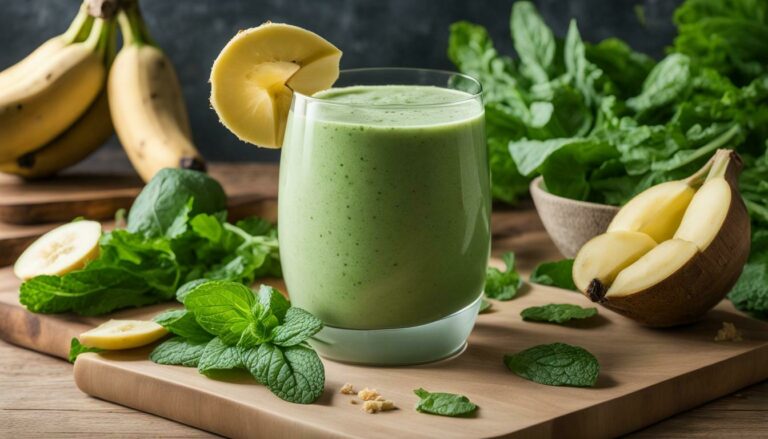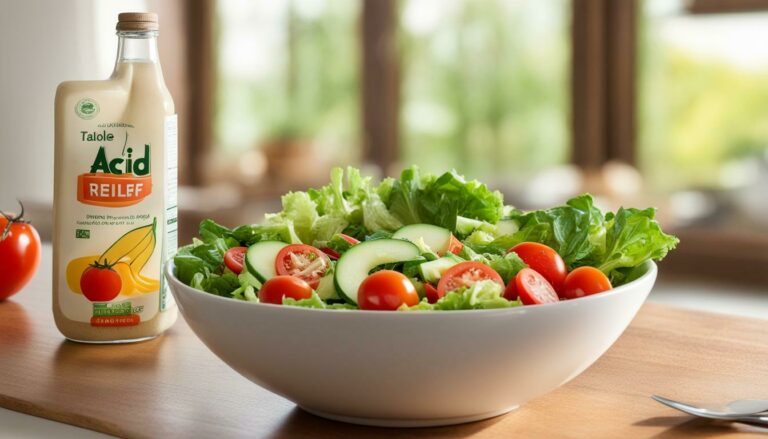If you suffer from acid reflux, you may be hesitant to indulge in your favorite pizza. However, with the right knowledge and choices, pizza can still be enjoyed without triggering your symptoms. In this article, we discuss how pizza can have an impact on acid reflux and share tips for choosing toppings and eating pizza in a way that minimizes symptoms.

Key Takeaways:
- Pizza can trigger acid reflux symptoms due to its high-fat content and acidic toppings.
- Choosing the right pizza toppings, such as vegetables and lean proteins, can help manage acid reflux effectively.
- Opting for thin-crust pizzas and white sauce can help minimize symptoms when eating pizza.
- Making your own acid reflux-friendly pizza at home is an excellent option.
- Adopting lifestyle changes such as avoiding trigger foods and maintaining a healthy weight can support acid reflux management.
How Can Pizza Trigger Acid Reflux?
Heartburn, GERD, indigestion, and stomach acid are all common issues that can be triggered by eating certain foods, such as pizza. Pizza can be a culprit due to several reasons:
- The high-fat content in cheese, pepperoni, and sausage can cause the lower esophageal sphincter (LES) to relax, leading to acid reflux.
- Tomatoes, garlic, and onions, commonly found in pizza sauces, are acidic and can contribute to heartburn.
- The consumption of large portions and overeating can put pressure on the stomach, forcing stomach acid to flow back up into the esophagus.
These factors can cause discomfort and disrupt your overall dining experience. Fortunately, there are alternative ways to enjoy pizza without triggering acid reflux symptoms.
Choosing the Right Pizza Toppings for Acid Reflux
When it comes to managing acid reflux while enjoying pizza, the choice of toppings is crucial. Opt for toppings with lower fat content, such as vegetables and lean meats. Avoid acidic ingredients like tomatoes, garlic, and onions. Instead of regular cheese, consider using a low-fat or lactose-free cheese alternative. Skip high-fat toppings like pepperoni and sausage, as they can exacerbate acid reflux symptoms.
| Toppings to Choose | Toppings to Avoid |
|---|---|
|
|
By making smart choices with your pizza toppings, you can reduce the likelihood of triggering acid reflux symptoms. Choosing vegetables and lean meats ensures that your pizza is still packed with flavor and nutrition, without the added fat content that can cause problems. Be wary of acidic ingredients like tomatoes and onions, which can contribute to heartburn and indigestion. And don’t despair – with low-fat cheese alternatives and non-acidic sauces like pesto, you can still enjoy a delicious pizza without any discomfort.
Next up, we’ll explore strategies for eating pizza in a way that minimizes acid reflux symptoms.
How to Eat Pizza with Acid Reflux
As a pizza lover with acid reflux, you may be wondering how you can still enjoy your favorite food without triggering uncomfortable symptoms. The good news is that there are strategies you can use to eat pizza in a way that minimizes acid reflux. Here are some tips to help you out:
- Opt for a thin-crust pizza instead of a thick one. Thin-crust pizzas usually have less fat and are easier to digest, which can help reduce acid reflux symptoms.
- When ordering your pizza, choose a white sauce instead of a tomato-based sauce. White sauces are generally less acidic, which can be easier on your stomach.
- Eat smaller portions and take your time to chew thoroughly. Eating too much or too quickly can put pressure on your stomach, leading to acid reflux symptoms.
By following these simple tips, you can still enjoy your favorite pizza without experiencing uncomfortable acid reflux symptoms. So go ahead and indulge, but remember to eat mindfully!
Managing Acid Reflux Alongside Pizza
If you frequently suffer from acid reflux, you don’t need to give up pizza entirely. There are ways to create an acid reflux-friendly pizza that won’t trigger symptoms. First, choose a whole wheat or gluten-free crust option to increase fiber content and decrease fat intake. Next, experiment with different toppings that won’t aggravate acid reflux symptoms.
Opt for vegetables that are low in acid, like mushrooms, bell peppers, and spinach. Lean proteins like grilled chicken or shrimp are also good choices. For cheese, try a low-fat or lactose-free alternative. Avoid toppings like tomatoes, garlic, and onions that can cause heartburn.
When it comes to sauces, stick to a non-acidic white sauce instead of tomato-based sauces. You can also try making a pizza with pesto or olive oil instead of sauce altogether.
By carefully selecting your pizza toppings, you can create an acid reflux-friendly pizza that still tastes great and won’t aggravate your symptoms.
Lifestyle Changes to Support Acid Reflux Management
While choosing the right pizza toppings is essential, achieving lasting relief from acid reflux requires adopting a holistic approach. Here are some important lifestyle changes you can make to support your acid reflux management:
- Avoid eating large meals close to bedtime: Lying down immediately after eating can worsen symptoms of acid reflux. Try to eat at least three hours before bedtime to give your stomach enough time to digest the food.
- Maintain a healthy weight: Being overweight or obese can increase pressure on the stomach, forcing acid to flow back up into the esophagus. Aim to maintain a healthy weight by following a balanced diet and regular exercise routine.
- Exercise regularly: Exercise can help improve digestion and reduce stress, both of which contribute to acid reflux. Aim for at least 30 minutes of moderate-intensity exercise most days of the week.
- Avoid trigger foods and beverages: Certain foods and drinks can exacerbate acid reflux symptoms, such as caffeine, alcohol, spicy foods, and acidic fruits and vegetables. Identify your trigger foods and limit or avoid them altogether.
By incorporating these lifestyle changes into your routine, you can support your acid reflux management and minimize the likelihood of experiencing uncomfortable symptoms.
You may also like to read:
12 Dinner Recipes For Acid Reflux Sufferers
Soothing Ice Cream for Acid Reflux: Delicious Help is Here!
Discover the Perfect Pasta Sauce for Acid Reflux Relief
Find Relief: Best Smoothie Recipe for Acid Reflux
Discover the Best Salad Dressing for Acid Reflux Relief
Conclusion
It’s good news for pizza lovers with acid reflux – you can still enjoy your favorite food! By making mindful choices, you can minimize the symptoms and avoid discomfort. Remember that pizza can trigger acid reflux due to its high-fat content and acidic ingredients like tomatoes, garlic, and onions. But you can choose the right pizza toppings, like vegetables and lean meats, to manage your condition effectively.
When eating pizza, opt for thin-crust options, and choose a pizza with a white sauce instead of a tomato-based sauce. Take your time to chew thoroughly and avoid overeating. If you frequently suffer from acid reflux, making your own acid reflux-friendly pizza at home with whole wheat or gluten-free crust options and non-acidic sauces can be a great option.
Don’t forget that managing acid reflux effectively requires lifestyle changes too. Avoid eating large meals close to bedtime and maintain a healthy weight. Exercise regularly and steer clear of trigger foods and beverages like caffeine, alcohol, and spicy foods. By adopting these lifestyle changes and mindful pizza choices, you can enjoy your favorite food without sacrificing your comfort.




